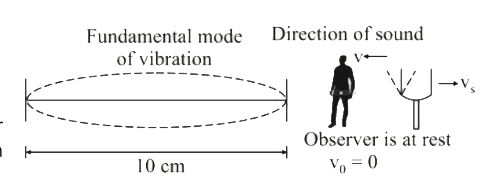A sonometer wire under tension of 63 N vibrating in its fundamental mode is in resonance with a vibrating tuning fork. The vibrating portion of that sonometer wire has a length of 10 cm and a mass of 1 g. The vibrating tuning fork is now moved away from the vibrating wire with a constant speed and an observer standing near the sonometer hears one beat per second. Calculate the speed with which the tuning fork is moved if the speed of sound in air is 300 m/s.
The correct Answer is:0.752
Linear mass density of sonometer wire μ=m1=0.0010.1=0.01kh/m
Velocity wave v=√Tμ=√640.01=80m/s
For fundamental frequency
Also, λ2=0.1⇒=0.2∴f=vλ=800.2=400Hz since tuning forks is in resonance ,therefore frequency of tuning fork is 400 Hz.The observer is hearing one beat per second when the tuning fork is moved away with constant speed v.
, The frequency of tuning fork as heard by the observer standing staionary near sonometer wire can be found with the help of doppler effect.
Using f'=f0[v−v0v−(−vs)]=vf0v+vs∴f'400×300300+vs
Since the beat frequency is 1 and as the tuning fork is going away from the observer,its apparent frequency should be 399 Hz.
∴399=400×300300+vs⇒vs=300399=0.752m/s

Similar Questions
A sonometer wire under tension of 64 N vibrating in its fundamental mode is in resonance with a vibrating tuning fork. The vibrating portion of the sonometer wire has a length of 10 cm and mass of 1 kg. The vibrating tuning fork is now moved away from the vibrating wire with a constant speed and an observer standing near the sonometer hears one beat per second. Calculate the speed with which the tuning fork is moved, if the speed of sound in air is 300 m/s.
View SolutionA sonometer wire under tension of 64N uibrating in its fundamental mode is in resonance with a uibrating tuning fork . The uibrating portion of the sonemether wire has a length of 10cm and mass of 1g . The uibrating tuning fork is now moved away from the uibrating wire with a constant speed and an observer standing near the sonometer hears one beat per second . Calculate the speed with which the tuning fork is moved , if speed of sound in air is 300m/s .
View Solution
Knowledge Check
A tuning fork produces 4 beats/s with a sonometer wire when its lengths are 50cm , 51cm . The frequency of that tuning fork is
A400HzB404HzC408HzD412HzA sonometer wire of length L1 and vibrating in its fundamental mode is in unison with a tuning fork of frequency n. When the vibrating length of the same wire is reduced to L2, it produces x beats/second with the fork.
What is the frequency of teh fork ?AL1(L1−L2)xB(L2L1−L2)xC(L1−L2L1x)D(L1−L2L2x)When a sonometer wire vibrates in the second overtone, there are
Athree nodes and three antinodesBfour nodes and three antinodesCone node and two antinodesDtwo nodes and three antinodes
A sonometer wire under tension of 128N vibrates in resonance with a tuning fork . The vibrating portion of sonometer wire has length of 20cm and mass 1g. The vibrating wire at constant speed of 0.75m/s and an observer standing near the sonometer hear 1beat/s. Find the speed of sound in air.
View SolutionA sonometer wire of length l vibrates in fundamental mode when excited by a tunning fork of frequency 416 Hz. If the length is double keeping other things same the string will
View SolutionFor a vibrating tuning fork is put in contact with the sonometer box then the rider on the wire falls down. The frequency of tuning fork, as the compared to that of the sonometer wire will be -
View SolutionA sonometer wire vibrating in its fundamental mode, is in unison with a tuning fork when the length of the wire between the bridges is 25 cm. By keeping the same tension , the length between the bridges is increased to 75 cm. The tuning fork can still be in resonance with the vibrating wire , provided the wire vibrates with
View SolutionA sonometer wire having a length of 50 cm is vibrating in the fundamental mode with a frequency of 100Hz. Which of the following is the type of propagating wave and its speed?
View Solution